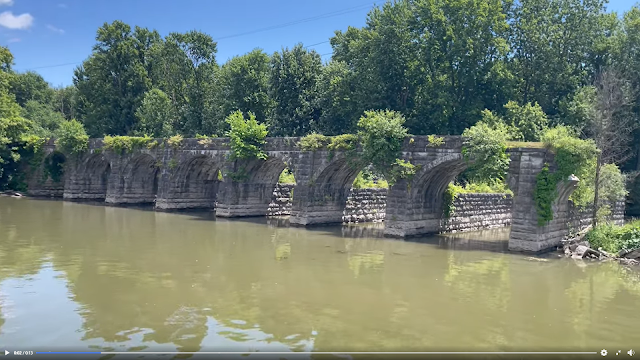(
Satellite, 207 photos)
Erie Canal Overview
 |
Cori Wilson posted
The Richmond Aqueduct, also known as the Seneca River Aqueduct or Montezuma Aqueduct, was over 840 feet [256m] long and 50 feet [15m] wide. Construction began in January 1849 and was completed in spring 1857. The aqueduct was the second largest on the Erie Canal and was designed by American Civil Engineer and politician Van Rensselaer Richmond. |
 |
Bob Baran commented on Cori's post
the pic in the post is a b/w photo ... its form my family photos ... i have the original and the glass negative for it ... kind of shocked to see it ... but pleased it is being used |
 |
ErieCanal, 1 of several photos
"The second longest of the Erie Canal aqueducts, the Seneca River Aqueduct was 840 feet, 5 1/2 inches long. Thirty piers and two abutments of Onondaga limestone supported a heavy timber trough which carried canal water over the river. Thirty-one stone arches supported the towpath." |
 |
tug44, 1 of several photos
"It enabled the Enlarged Erie Canal to pass over the Seneca River....Building this Aqueduct proved extremely difficult as the site was bottomless muck. Wooden pilings were driven 190 feet [58m] deep and no rock was found. Eventually a "mattress" built of logs was sunk to the bottom of the Seneca River and the stone construction was built on top of this base." |
 |
tug44
"This view shows the stonework of the Old Richmond Aqueduct is still in fine condition after 155 years in the elements." |
 |
ErieCanal_historical
"When the Enlarged Erie Canal was replaced by the Barge Canal in 1917, part of the aqueduct was torn down to give boats clear run of the river, which serves as the canal of today. Today, seven arches remain on the east shore and three arches remain on the west shore." |
John Kucko Digital
posted five photos with the comment: "The Erie Canal at 200 (#28): Continuing my weekly series here on the page commemorating the bicentennial of the iconic Erie Canal. There is some FANTASTIC Erie Canal history in and around Montezuma, NY in Cayuga County. The Montezuma Heritage Park is a terrific spot to learn about Erie Canal history, as well as get a good hike in. Central to the canal history here is the remains of the old Seneca River Aqueduct, also known as the Richmond Aqueduct or Montezuma Aqueduct (first image). Construction began in 1849 and this was operational beginning in 1857. 30 piers and and a pair of abutments of Onondaga limestone supported a heavy timber trough which carried canal water OVER the river. 31 stone arches supported the towpath. When the Barge Canal came to be in 1917, part of this aqueduct was taken down to clear the way for boats on the river. 10 of the arches remain, 7 on the east side and 3 on the west—it’s a VERY cool sight, though a lengthy hike to see it. The trailhead has a neat replica wooden boat with a beautiful mural, a REALLY cool birdhouse—lots of open space. This is a wonderful little park where history is celebrated in a big way!"
Jordan Historical Society & Museum: One of our favorite places along the canal. Volunteers there have created a major destination at Montezuma.
We believe it was the second largest aqueduct along the canal. Are we correct Old Mentz Heritage Center?
Montezuma Heritage Park Friends: Jordan Historical Society & Museum Yes, thank you. it was the second largest aqueduct on the Enlarged Erie Canal. Volunteers have worked to develop it and helped the town maintain this park for over 15 years. We are an aging group, and we need help or it will go back to the same overgrown hidden gem it used to be and not known for the significance it was part of. with the Canal System. .
 |
| 1 |
 |
| 2 |
 |
| 3 |
 |
| 4 |
 |
| 5 |
 |
Vicki Thompson Cammer commented on the John's first photo
In 1998 my then 15 year old son and I discovered the aqueduct on while out riding in our boat. It was like discovering Macchu Pichu! Remarkable structure! |
 |
| Brian Dudley commented on John's post |















No comments:
Post a Comment